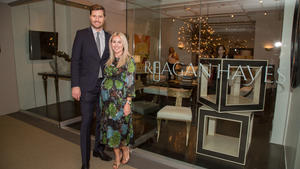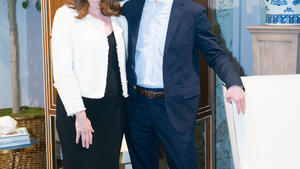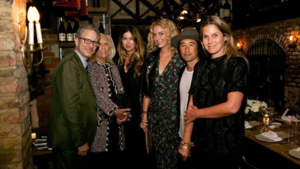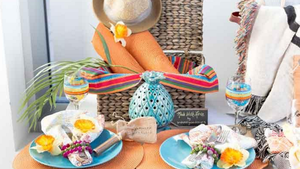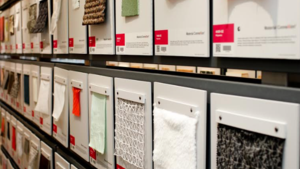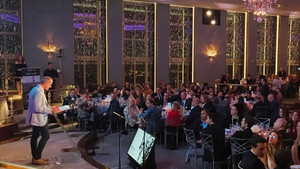“Inspiring” was the word many members of the Design Leadership Network (DLN) used to describe the ninth-annual Design Leadership Summit in New York City last week, an event that attracted nearly 250 thinkers, innovators and creative minds eager to explore design issues and innovations present and future.
Co-hosted by Peter Sallick, DLN founder and CEO of Waterworks and Dering Hall, Kate Kelly Smith, SVP publishing director and chief revenue officer of Hearst Design Group, and John Edelman, CEO of Design Within Reach, the event kicked off Tuesday evening, Nov. 4, with a presentation by iconic New York author Fran Lebowitz and T: The New York Times Style Magazine Editor in Chief Deborah Needleman at Cedar Lake in Chelsea.
Design Leadership Summit co-hosts Peter Sallick, Kate Kelly Smith and John Edelman
Needleman and Lebowitz discussed the state of New York City post-Mayor Bloomberg—that is, the urban landscape, the architecture, and the city's future. Ultimately, the discussion turned toward what design means to Lebowitz.
"It think that people think that architects are the same as interior designers,” said Lebowitz. “They think clothes design is the same thing as furniture design. These things are not really even related in my mind. They are all different. My father was an upholsterer. My mother was at some point an interior designer. I grew up in a sea of swatches. These things are of extreme and profound importance to me and always have been. These are also things that you have to know about to know about. There is such a thing as talent and expertise and those things are important."
Deborah Needleman and Fran Lebowitz
She added: "Architecture in New York City should be urban as opposed to suburban. It shouldn’t be made out of glass and Scotch tape, which is what it looks like to me.”
On day two of the summit, the group traveled to the United Nations, which just emerged from a seven-year, $2-billion renovation.
Members first heard from UN Assistant Secretary General Michael Adlerstein, who spoke about the renovation and urged designers and architects to “recycle buildings and stop with all the new construction.”
Michael Adlerstein
He explained that by re-using the building that was originally there, the UN preserved its historical impact on the city while reducing its carbon footprint by more than 45 percent.
Next up to speak were Lydia Muniz and Casey Jones of the U.S. Department of State Bureau of Overseas Buildings Operations, which maintains and creates U.S. embassies and housing in foreign countries. The pair chatted with architecture critic Paul Goldberg, who asked how designers and architects could bid on those jobs, and what’s considered when working on those projects.
Jones explained that when searching for an architect to do a new embassy, it's not always the big names they are looking for, but instead someone who is willing to explore the culture and take risks, someone who values security and sustainability. “It’s not a one-size-fits-all task,” he said.
Paul Goldberger, Lydia Muniz and Casey Jones
“The most complicated issues bring out the most creative solutions,” Muniz said. “Good design and good security are mutually important."
“Architecture shows what society values and communicates who we are as a culture,” Muniz said. She then went on to explain that the values of the bureau have changed, that they are now looking to work with a younger generation of architects who have a strong team behind them.
“We set a budget for the project prior to putting out a request for bids,” said Muniz. “So anyone who is applying knows that budget, it makes it less about the money.”
Keeping with the international theme, Editor in Chief of ELLE DECOR Michael Boodro welcomed to the stage four international interior designers, who had traveled from around globe to share stories about the state of design in their countries.
Thomas Hamel of Australia, Isay Weinfield of Brazil, Dorothee Boissier of France and Sonali Rastogi of India shared images and videos of residential and hospitality projects they have in the works. Rastogi focused in on her efforts to make India a greener and more functional place.
Thomas Hamel, Michael Boodro, Isay Weinfield, Dorothee Boissier and Sonali Rastogi
The panel shed light on the diverse challenges of the industry, from Hamel’s difficulty shipping great design pieces to Australia due to astronomical shipping costs to Weinfield’s struggle with American designers coming into Brazil and scooping up potential clients.
Architect and artist Maya Lin, who spoke about art and the environment, then asked designers to really commit to sustainable design and beseeched them to worry about the state of the environment and the planet.
She said the main issue with our culture ruining the environment is that “we don’t think about it if it’s out of sight. We don’t see what we are polluting or the damage that we are doing.”.
Maya Lin
Through her nonprofit work, (she founded whatismissing.net—with a mission to create, through science-based artworks, an awareness about the current environmental crisis) Lin has created large-scale models of rivers and bays and suspended them in the air to artistically demonstrate the extent of damage they are doing.
“Do we think about it if it’s out of sight?” asked Lin. With that thought in mind, her goal is to ask people to “Take a step back, pause, and look at it again.”
After Lin’s presentation, Surface Magazine Executive Editor Spencer Bailey and architecture photographer Iwan Baan shared the architectural photography Baan had created throughout his career, including views of Los Angeles from a helicopter and Zaha Hadid-designed buildings in the Middle East.
Iwan Baan and Spencer Bailey
“Photographers go to great lengths to tell the story of a building,” Baan said. “We really create the voice of that building.”
Sprinkled throughout the day were various “moments of inspiration” including landscape architect Bob Truskowski and architect Richard Landry, who shared images of their work and the stories of their careers.
Richard Landry
“When I work with clients, I always tell them to do some soul searching,” Landry said. “Find what kind of architecture speaks to you. Don’t follow trends.”
The summit also debuted its Design Leadership Award, presenting the inaugural honor to Marc Appleton, principal at Appleton & Associates, Inc., at an awards presentation at Parsons The New School. The event included a video “roast” featuring Appleton’s wife, actress Joanna Kerns, his son, interior designer Suzanne Tucker and former professor and collaborator Allan Greenberg.
Marc Appleton
“He [Appleton] has worked throughout an impressive career to design exceptional client projects, and also invest in scholarship, community, and mentorship in ways that have touched a countless number of us in the DLN membership, and in the industry,” the summit's co-hosts remarked.
Following the ceremony, the group broke into groups of 15-20 and headed to pre-arranged dinners at various restaurants.
Stay tuned for highlights from day three of the Design Leadership Summit.
Photo Credit: John Calabrese Photography

















